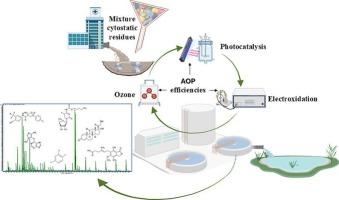利用对高级氧化工艺的见解进行四元处理
IF 6.7
2区 工程技术
Q1 ENGINEERING, CHEMICAL
引用次数: 0
摘要
本研究评估了臭氧化、光催化和电氧化处理含有17种细胞抑制化合物的25 μg/L城市污水处理厂废水的效率。该浓度使我们能够评估不同处理的效率,达到质谱检测的良好灵敏度,避免样品处理,并在必要时研究动力学。城市废水中存在的细胞抑制药物由于其毒性和持久性而引起重大的环境和健康问题。传统的污水处理厂(WWTPs)只能去除这些污染物的一部分,需要增加额外的工艺。用200 mg O₃/L进行臭氧化处理,10种化合物的去除率超过90%,7种化合物的去除率低于60%。在tio2 (500 mg/L)光催化下,4种化合物的去除率超过90%,其余13种化合物的去除率低于75%。电氧化对17种化合物中的14种有效,平均去除率为75%,对8种化合物的平均去除率为94%。结果表明:1)单一技术不能实现对所有污染物的高去除,2)所有化合物都被至少一种处理方法去除,3)存在知识碎片化,大多数实验室研究不能预测复杂废水处理的动力学行为。需要整合多种技术(如电氧化和臭氧化)来提高污水处理厂的整体去除效率并实现更严格的立法。有必要进一步研究潜在的挑战,如副产品毒性和能源消耗。本文章由计算机程序翻译,如有差异,请以英文原文为准。

Leveraging insights into advanced oxidation processes for quaternary treatments
This study assesses the efficiency of ozonation, photocatalysis, and electrooxidation to treat the effluent from an urban WWTP spiked with a mixture of 17 cytostatic compounds at 25 μg/L. This concentration allowed us to assess the efficiency of the different treatments, reaching good sensitivity for mass spectrometry detection avoiding sample treatments and study the kinetics when necessary. The presence of cytostatic drugs in urban wastewater poses significant environmental and health concerns due to their toxicity and persistence. Conventional wastewater treatment plants (WWTPs) only remove part of these contaminants, being necessary to add additional processes. Ozonation with 200 mg O₃/L achieved over 90 % removal for ten compounds, while the removal of seven compounds was below 60 %. Photocatalysis with TiO₂ (500 mg/L) degraded four compounds by over 90 %, but the removal of the other 13 compounds was below 75 %. Electroxidation was effective for removing 14 out of the 17 compounds with an average global removal of 75 % and 94 % for eight compounds. Results showed: i) single techniques do not achieve a high removal of all contaminants, ii) all compounds were removed by at least one of the treatments, and iii) there is a fragmentation of knowledge, and most lab studies do not predict the kinetic behavior of treatments of complex wastewater. The integration of multiple technologies (e.g. electrooxidation and ozonation would be needed to enhance the overall removal efficiency of WWTPs and accomplish stricter legislation. Further studies on potential challenges as by-product toxicity and energy consumption are necessary.
求助全文
通过发布文献求助,成功后即可免费获取论文全文。
去求助
来源期刊

Journal of water process engineering
Biochemistry, Genetics and Molecular Biology-Biotechnology
CiteScore
10.70
自引率
8.60%
发文量
846
审稿时长
24 days
期刊介绍:
The Journal of Water Process Engineering aims to publish refereed, high-quality research papers with significant novelty and impact in all areas of the engineering of water and wastewater processing . Papers on advanced and novel treatment processes and technologies are particularly welcome. The Journal considers papers in areas such as nanotechnology and biotechnology applications in water, novel oxidation and separation processes, membrane processes (except those for desalination) , catalytic processes for the removal of water contaminants, sustainable processes, water reuse and recycling, water use and wastewater minimization, integrated/hybrid technology, process modeling of water treatment and novel treatment processes. Submissions on the subject of adsorbents, including standard measurements of adsorption kinetics and equilibrium will only be considered if there is a genuine case for novelty and contribution, for example highly novel, sustainable adsorbents and their use: papers on activated carbon-type materials derived from natural matter, or surfactant-modified clays and related minerals, would not fulfil this criterion. The Journal particularly welcomes contributions involving environmentally, economically and socially sustainable technology for water treatment, including those which are energy-efficient, with minimal or no chemical consumption, and capable of water recycling and reuse that minimizes the direct disposal of wastewater to the aquatic environment. Papers that describe novel ideas for solving issues related to water quality and availability are also welcome, as are those that show the transfer of techniques from other disciplines. The Journal will consider papers dealing with processes for various water matrices including drinking water (except desalination), domestic, urban and industrial wastewaters, in addition to their residues. It is expected that the journal will be of particular relevance to chemical and process engineers working in the field. The Journal welcomes Full Text papers, Short Communications, State-of-the-Art Reviews and Letters to Editors and Case Studies
 求助内容:
求助内容: 应助结果提醒方式:
应助结果提醒方式:


